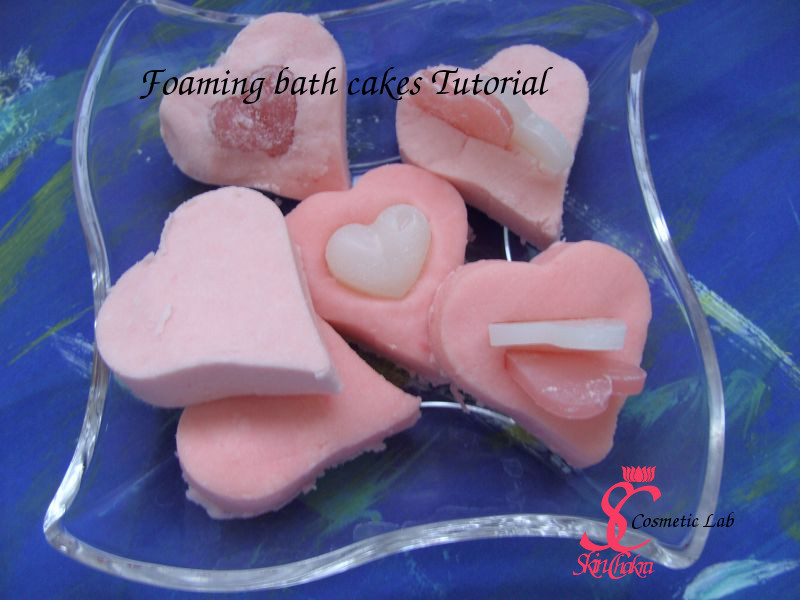
Dienstag, 21. Januar 2014
Valentine's Day Foaming bath cake
Ready for another Valentine's Day special?
This is a foaming bath cake. The recipe is very forgiving. There is absolutely nothing you can make wrong with this recipe. Even if the final result is not exactly the same as you've planned, still you'll not waste a single gram of your ingredients.
You may generally prepare this recipe in any desired color, form and fragrance. One basic recipe, 1001 variation. However for Valentine's Day I decided to prepare the bath cakes in heart shape, in pink and with rose fragrance.
This recipe is basically different from bath fizzies in which the bubbles or the effervescence is produced by the reaction of baking soda (sodium bicarbonate) and citric acid in water. Here the foam comes from an anionic surfactant: Sodium lauryl sulfoacetate, shortly called SLSA as well. This surfactant is delivered in 100% active matter and as a powder so that it could be mixed with other powdered ingredients and in water-free formulations. As you add the bath cake under running water or add it to the tub water, the cake dissolves and the surfactant foams. Logically the more you agitate through the water (running water over the cake into the bath tub) the more voluminous the lather.
The base is prepared with a consistency similar to pizza dough. You then cut the dough with cookie cutters into your desired forms (in this case hearts). No pressing into molds not pressing out of molds, quite simples and failure free.
Testimony: SLSA in undiluted form could be irritating to respiratory tract and eyes (it is a very fine, free flowing powder). However in diluted form in bath products and during application (dissolved in water) it is quite safe and causes no irritations. Please do apply a mouth mask, latex or nitrile gloves and eventually safety goggles (if you have sensitive eyes and mucous membrane) as you work with this material in the cosmetic lab.
You may prepare the hearts more attractive and to add more flair to them, I've applied the simple glycerin heart soaps we've prepared in a previous project to them. It's totally up to you whether you prepare the hearts simple and pure or add soap pieces to them.
Before we start I want to recommend you to read our older posts about general information regarding hygienic manufacturing practice in cosmetic lab and introduction to Basic equipments and utensils for a cosmetic lab.
Since the outcome depends mainly on your cookie cutters, I simple mention ratios as percentage here so that you can adapt the recipe to your cookie cutter and those of you not familiar with metric system can still apply the recipe without the pain of conversion between ounce and pound and ml and gr.
For this recipe you'll need:
60,0% Sodium bicarbonate
20,0% SLSA
8,0% lysolecithin
5,5% Fragrance oil "British English Rose"
5,0% corn starch
1,0% Poppy seed oil
0,5% Vitamin E
a few drops of D&C red #30 (dispersed in gylcerin)
a few pieces of the heart soaps we prepared in this project
You'll need as well:
a suitable bowl to mix the ingredients
cookie cutters (heart shaped)
glass rods and spatulas
disposable pipettes
probably a sieve to sieve your powdered material
a glass beaker to mix fluid ingredients
Here we go:
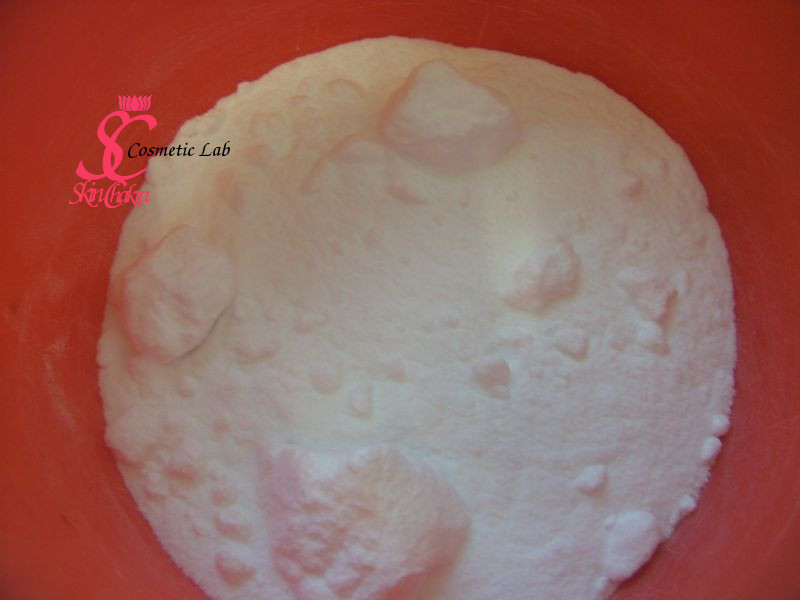
One: In a suitable bowl mix all of your powder ingredients (sodium bicarbonate, SLSA and starch). Wear gloves, mask and safety goggles if you have sensitive eyes.
Mix thoroughly the ingredients and break any existing clumps. You may need to sieve the powder blend through a kitchen sieve if the powder is not fine.
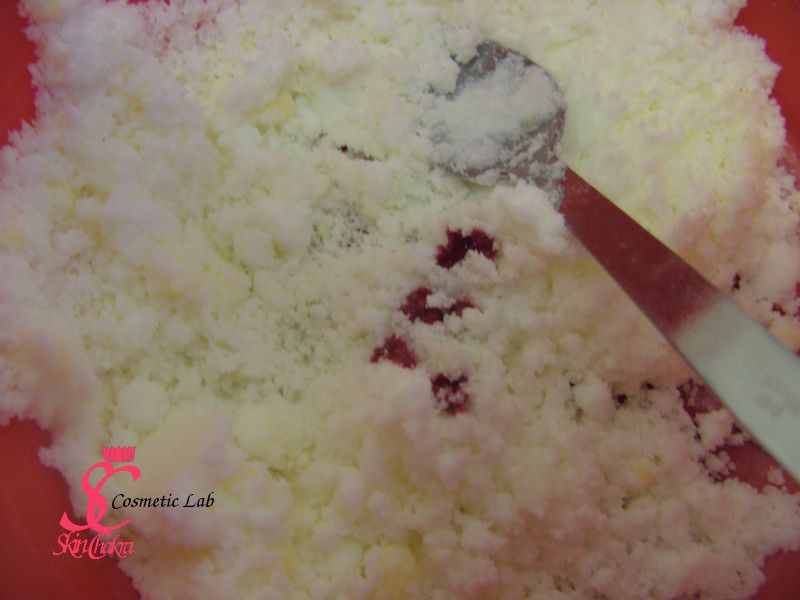
Two: add a few drops of the colorant to the powder mixture. Here less is more. The color dispersed very slowly in the mixture so please add it drop-wise and mix thoroughly before adding the next drop. (for 500 gr ingredients I've added 8 drops and it was quite enough)
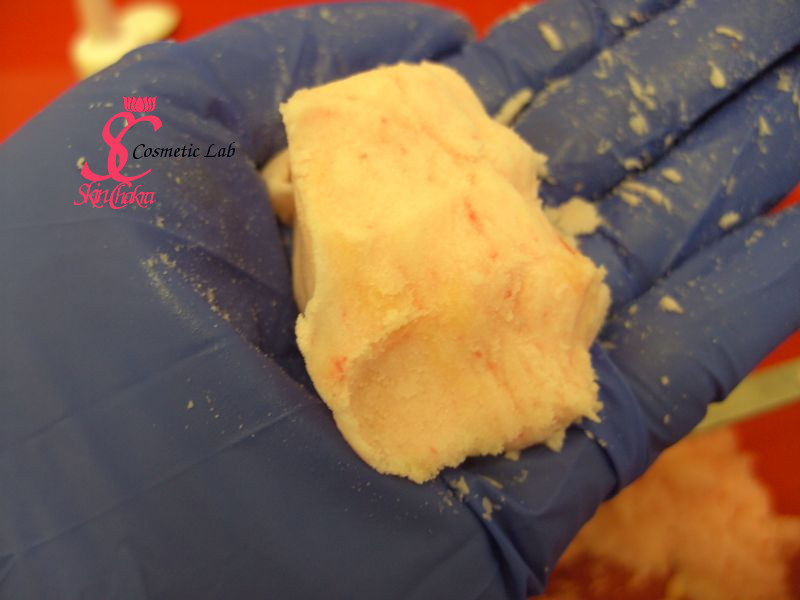
Three: Add lysolecithin, vitamin E and poppy seed oil to the powder mixture and mix well. Here you shall knead the mixture. After you're satisfied with the mixture add the fragrance oil. The consistency should be like pizza dough. You should be able to form the paste in your hands. If it is too dry and crumbly add a few drops of lysolecithin, if it is too runny and wet add 1-2 spoons of sodium bicarbonate. This step needs patience just like making cookies. You should really condition the paste and work with your hands. The more you knead, the better is the result.
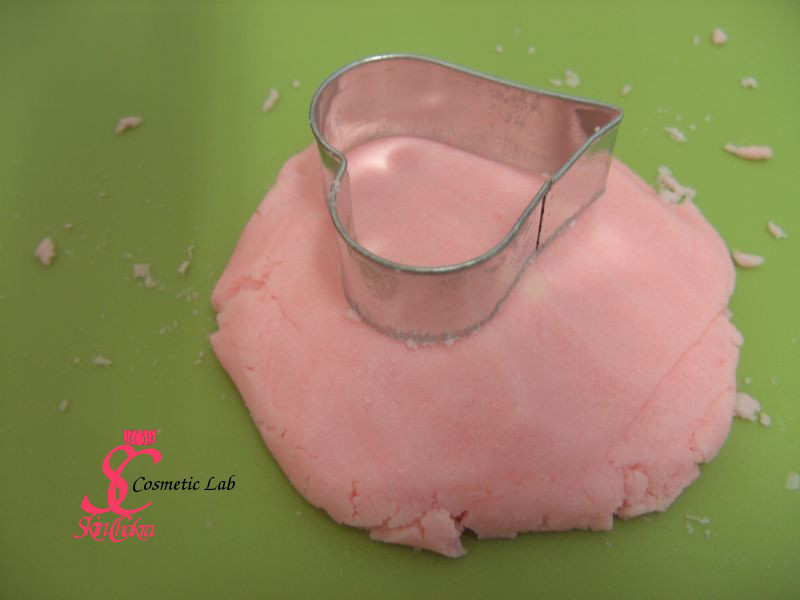
Four: After you're satisfied with the consistency of the paste spread it over your counter. You may spread some starch over the counter (under the paste) to avoid sticking the paste to the counter or your working surface. Cut the dough with your cookie cutter or
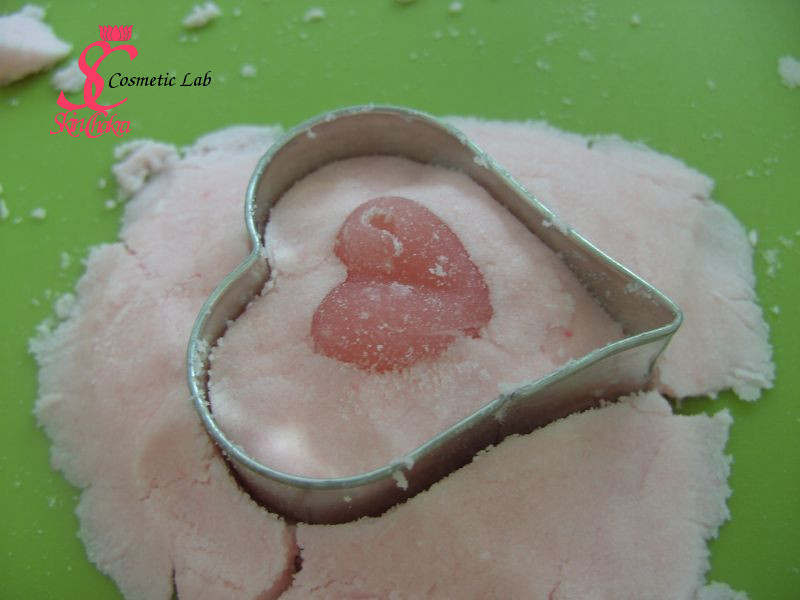
for a better result first insert the soap and then cut with cookie cutter.
You can embed the soaps or simply insert a part of the soap into the dough
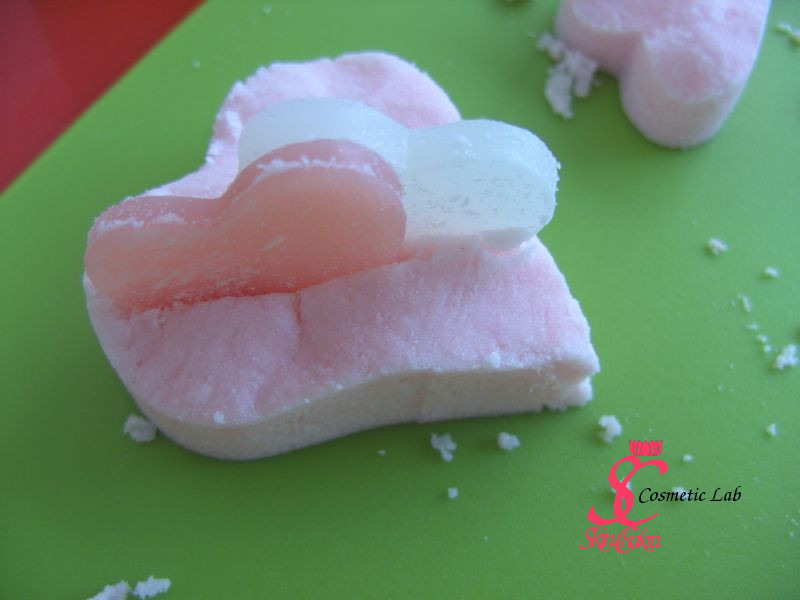
Depending on the original consistency and the ambient humidity it may take a couple of days (or years ![]() ) till your heart pieces harden.
) till your heart pieces harden.
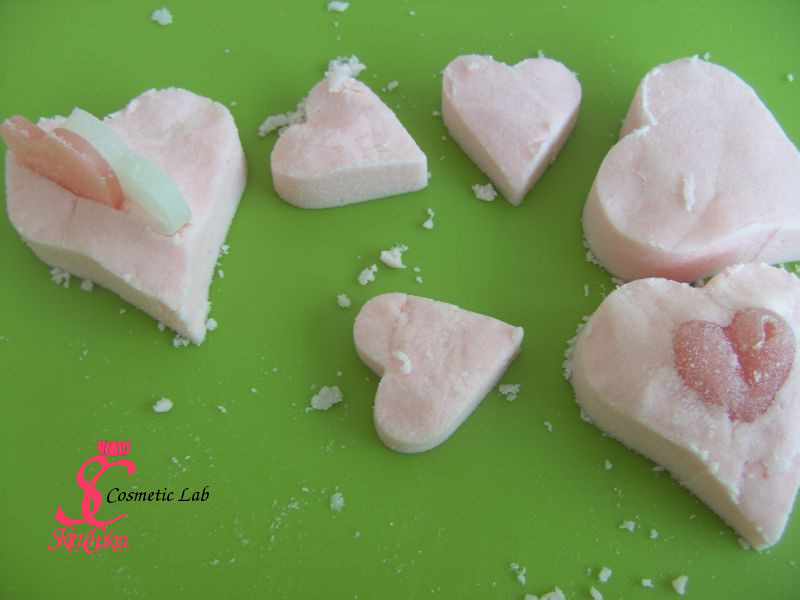
If you're leaving in a humid area, keep the hearts in a closed container to harden.
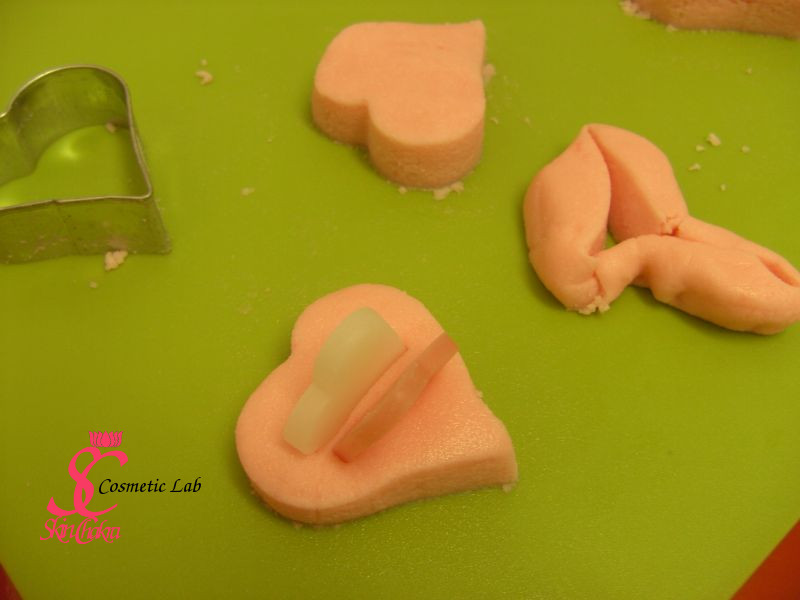
Do not discard the rests.

Shape the paste in your hands as it is still soft and insert one or two pieces of heart soap into it.
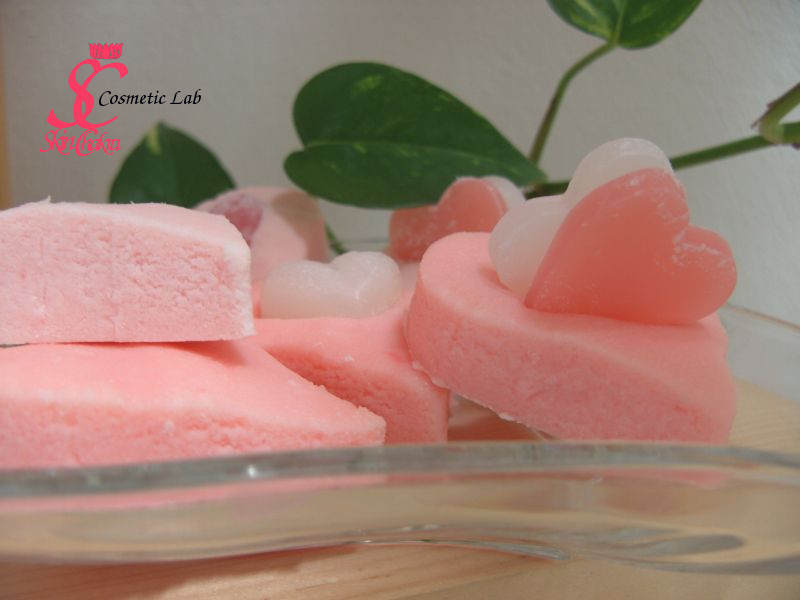
Voila, here are your beautiful bath cakes ready to be packed.
You can order all the ingredients for this project by SkinChakra® online shop.
BeHappy and have fun trying this project.


Swettis Beauty Blog am : Foaming foot bath tutorial
SC PaperDesign am : Valentine's days treats